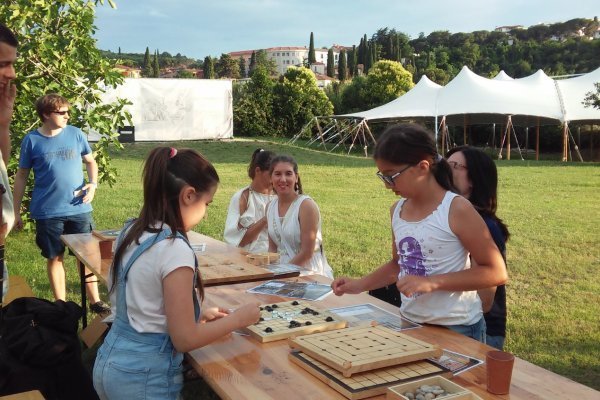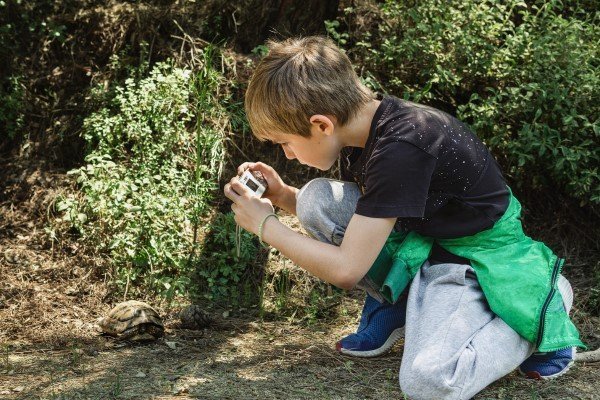Tuesday, 12 September 2023 29th Slovenian Science Festival Space-Earth-People
The event will be held between September 26 and 28 in Ljubljana and Koper with international participation.
The festival is organized by the Slovenian Science Foundation (SZF) and the University of Primorska.
The honorary patron is the Minister of Higher Education, Science and Innovation Igor Papič.
The event organizers want to encourage festival participants to think about the connection between man and the universe through science.
With the help of natural science and humanities experiments, shows, workshops, lectures, talks, exhibitions and field trials, the Slovenian Science Festival will present what it all represents about people's connection to nature and how our actions affect our planet.
In Ljubljana, the festival will take place on the premises of the Faculty of Chemistry and Chemical Technology of the University of Ljubljana. At our university, the festival events will take place in two locations, namely on the premises of the Faculty of Humanities and the Faculty of Mathematics, Natural Sciences and Information Technologies.
Location: classroom UP FHŠ
Workshop: Science from a Suitcase
Performance: 26., 27., 28.9. – 10 am -11:00 am and 26., 27.9. – 1 pm – 3pm
Researchers: Prof. Irena Lazar, Asist. Prof. Zrinka Mileusnić, Andrej Preložnik
 The workshop Earth in People: Science from a Suitcase contains various topics from life in antiquity, which come from copies of archaeological objects stored in interpretation suitcases. Children have the opportunity to pick up objects that are usually inaccessible and stored in glass cases and take a closer look at them. At the same time, they get to know topics from life in the past - writing and its development, medicine and hygiene among the Romans, nutrition and dietary habits, trade, etc.
The workshop Earth in People: Science from a Suitcase contains various topics from life in antiquity, which come from copies of archaeological objects stored in interpretation suitcases. Children have the opportunity to pick up objects that are usually inaccessible and stored in glass cases and take a closer look at them. At the same time, they get to know topics from life in the past - writing and its development, medicine and hygiene among the Romans, nutrition and dietary habits, trade, etc.
With that, of course, we explain to them how an archaeologist recognizes and chronologically places the found objects, how we learn about life in the past, what the objects mean and why they are important earth layers during archaeological excavations, and how the finds of Roman coins help them in this.
The following is a presentation of modern non-destructive chemometric analyses of individual materials and what kind of answers they can bring us. The workshop allows an experiential walk through visible and invisible archaeological heritage; thus acquainting the children with the modern methods of archaeologists' work and the importance of protecting, learning about and educating about our heritage and the importance of civic science.
Location: classroom UP FHŠ
Workshop: Earth and People: visible and invisible archaeological heritage
Performance: 26 and 27 of September, 9.00 am - 3 pm (45 to 60 minutes duration)
Researchers: Assoc. Prof. Boris Kavur in Assoc. Prof. Martina Blečić Kavur
 The workshop Earth and People: Visible and Invisible Archaeological Heritage is divided into two topics, Ceramics - Production and Archaeology and Copper - Metallurgy and Archaeology, which present in an interesting and entertaining way the selected archaeological heritage from the basic extraction of raw materials (from the earth) to the creative and innovative human production of individual objects in the past. This is followed by a presentation of archaeological processing methods and, in particular, modern non-destructive chemical analyses of individual materials. Then, digitalisation and the production of reconstructions and various replicas are presented. The multimedia presentations (presentations, previews of films and digitalised items in various formats) are based on a variety of content with innovative approaches, with the possibility of trying out various devices and direct tactile contact with objects of Slovenian and replicas of world archaeological heritage (e.g. the Venus of Willendorf). In this way, we provide an experiential walk through the visible and invisible archaeological heritage and introduce the children to the work of an archaeologist.
The workshop Earth and People: Visible and Invisible Archaeological Heritage is divided into two topics, Ceramics - Production and Archaeology and Copper - Metallurgy and Archaeology, which present in an interesting and entertaining way the selected archaeological heritage from the basic extraction of raw materials (from the earth) to the creative and innovative human production of individual objects in the past. This is followed by a presentation of archaeological processing methods and, in particular, modern non-destructive chemical analyses of individual materials. Then, digitalisation and the production of reconstructions and various replicas are presented. The multimedia presentations (presentations, previews of films and digitalised items in various formats) are based on a variety of content with innovative approaches, with the possibility of trying out various devices and direct tactile contact with objects of Slovenian and replicas of world archaeological heritage (e.g. the Venus of Willendorf). In this way, we provide an experiential walk through the visible and invisible archaeological heritage and introduce the children to the work of an archaeologist.
Location: Livade 1.0, Izola
Workshop for students of the 3rd triad elementary school, teachers are also invited.: Fantastic animals and where to record them
Date of performance: 26 and 27 of September, at 11 a.m. - 1 p.m. (the workshop lasts for an hour)
Researchers: Luka Duniš, Minja Krstić
 Primary and secondary school students and teachers will have the opportunity to take part in a treasure hunt called "Fantastic Animals and where to record them", where children will learn how to collect and use data on wildlife. They will also be introduced to the SRNA app, developed in the Step Change project, to collect wildlife data. During the workshop activities, students will be introduced to the principles of citizen science and learn how to record wildlife data using the SRNA app and how to use camera traps to monitor wildlife.
Primary and secondary school students and teachers will have the opportunity to take part in a treasure hunt called "Fantastic Animals and where to record them", where children will learn how to collect and use data on wildlife. They will also be introduced to the SRNA app, developed in the Step Change project, to collect wildlife data. During the workshop activities, students will be introduced to the principles of citizen science and learn how to record wildlife data using the SRNA app and how to use camera traps to monitor wildlife.
Location: Livade 1.0, Izola
Workshop for students of the 3rd triad elementary school, teachers are also invited: Wildlife Detective: unmasking the invisible wildlife around you
Date of performance: 26 and 27 of September, at 9 a.m. - 11 a.m. (the workshop lasts for an hour)
Researchers: Aja Bončina, assistant
 As part of the activity "Wildlife detective: revealing the invisible wildlife around you", students and teachers will learn how to efficiently monitor biodiversity with innovative approaches, based on modern, genetic methods. These approaches enable the understanding and research of many important wildlife features (what they eat, what kind of environment they live in, are their populations stable in nature, whether are they resistant to diseases, how we identify the entire biodiversity in just one reaction, etc.). Students and teachers will also learn the basics of field research, more precisely, how can we efficiently collect genetic samples from the environment (environmental DNA) or animals (e.g. collection of hair, faeces, and other traces). Appropriate collection and analysis, based on molecular data, enable the understanding of wildlife features and are consequently important for the species’ protection and management.
As part of the activity "Wildlife detective: revealing the invisible wildlife around you", students and teachers will learn how to efficiently monitor biodiversity with innovative approaches, based on modern, genetic methods. These approaches enable the understanding and research of many important wildlife features (what they eat, what kind of environment they live in, are their populations stable in nature, whether are they resistant to diseases, how we identify the entire biodiversity in just one reaction, etc.). Students and teachers will also learn the basics of field research, more precisely, how can we efficiently collect genetic samples from the environment (environmental DNA) or animals (e.g. collection of hair, faeces, and other traces). Appropriate collection and analysis, based on molecular data, enable the understanding of wildlife features and are consequently important for the species’ protection and management.




